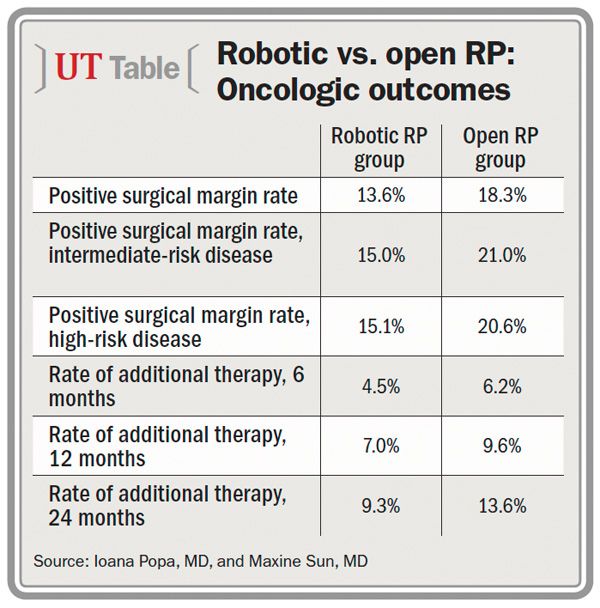Article
Robotic RP associated with improved margin status
Robot-assisted radical prostatectomy may be associated with improved surgical margin status compared to open radical prostatectomy for men with intermediate-risk and high-risk prostate cancer, according to a study presented at the AUA annual meeting in Orlando, FL.
Orlando, FL-Robot-assisted radical prostatectomy (RARP) may be associated with improved surgical margin status compared to open radical prostatectomy (ORP) for men with intermediate-risk and high-risk prostate cancer, according to a study presented at the AUA annual meeting in Orlando, FL.
Researchers also found that RARP was associated with a decreased need for androgen deprivation therapy (ADT) or radiotherapy post-prostatectomy compared to ORP.

Dr. Sun“This represents the first study to show that RARP may have some long-term oncological benefit compared to ORP, using surgical margins as a correlate. Previous studies from tertiary care centers were mostly inconclusive and lack generalizability,” said senior author Maxine Sun, MD, co-director of the Cancer Prognostics and Health Outcomes Unit in the department of urology at the University of Montreal Health Center in Montreal.
Exaggerated marketing claims and higher upfront costs have been among the barriers to clinicians adopting robotic technology. In addition, few clinically significant benefits have been shown when RARP is compared to ORP.
In the current study, researchers from several institutions analyzed Surveillance, Epidemiology, and End Results data and identified 5,556 patients treated with RARP and 7,878 treated with ORP between 2004 and 2009. The authors conducted propensity-based analyses to minimize treatment selection biases and used generalized linear regression models for comparison of radical prostatectomy surgical margin status and use of additional cancer therapy by surgical approach. Mean patient age was 69 years, and 85% were Caucasian.

Continue to the next page for more.
Findings could have QoL, cost implications
The authors found that RARP may be associated with improved surgical margin status among intermediate- and high-risk patients, as well as a decreased use of ADT and radiotherapy in the postoperative setting. Such findings may be associated with important implications with respect to quality of life and costs.

Dr. Popa“We looked at additional therapy after prostatectomy at 6, 12, and 24 months. We found that robot-assisted radical prostatectomy had lower rates of positive surgical margins than open radical prostatectomy, even for patients who had intermediate- and high-risk prostate cancer. What we also found was that for robot-assisted radical prostatectomy, the rates of use for additional cancer therapies (radiation and/or ADT) at 6, 12, and 24 months were lower,” said first author Ioana Popa, MD, a urology resident at the University of Montreal.
The incidence of positive surgical margins was significantly lower among men undergoing RARP (13.6% compared to 18.3% for ORP). The authors noted significant differences in men with intermediate-risk disease, with a positive surgical margin rate of 15% for RARP versus 21% for ORP. The findings for high-risk disease patients were similar as well (15.1% for RARP vs. 20.6% for ORP). Additionally, RARP was associated with less use of additional cancer therapy within 6 months (4.5% vs. 6.2% at 6 months, 7.0% vs. 9.6% at 12 months, and 9.3% vs. 13.6% at 24 months).
“The current study provides some reassurance amidst controversies and skepticism regarding the robot-assisted approach in the context of prostate cancer, since it is the first to show, using a large population-based cohort, that RARP may be associated with improved long-term oncological outcomes compared to ORP for men with intermediate- and high-risk disease,” Dr. Sun said. “Hence, the current results also support existing consensus toward active surveillance in men with low-risk prostate cancer.”
Dr. Sun and her colleagues believe further studies are warranted to examine total costs of the two procedures and the subsequent cancer therapies’ costs over 2 to 3 years after radical prostatectomy.UT
More on Prostate Cancer
Risk for other cancers rises after prostate cancer RT
Clinicians say active surveillance is effective but rarely recommend it
PCa screening: Shared decision making infrequent
Subscribe to Urology Times to get monthly news from the leading news source for urologists.
Newsletter
Stay current with the latest urology news and practice-changing insights — sign up now for the essential updates every urologist needs.













